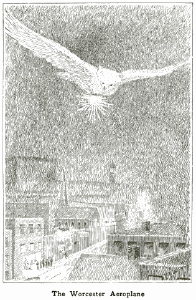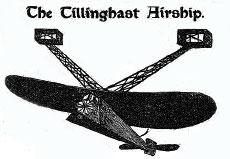In early December, 1909, American newspapers excitedly reported that Wallace Tillinghast, an inventor from Worcester, Massachusetts, had built the world's most advanced airplane. His craft could carry three passengers, cover a distance of over 300 miles, and maintain a speed of 120 miles-per-hour.
This was far beyond the capability of any airplane built to that point in time. It was only in 1903 that the Wright brothers had succeeded in flying the first heavier-than-air craft. In July 1909 Louis Blériot had achieved international fame by flying across the English Channel, a distance of only 22 miles.
Tillinghast's airplane was of a curious design. It was described as
"a monoplane, weighing 1,550 pounds, with a spread of 72 feet, and equipped with a 120 horse power gasoline engine of special construction." In addition, it had
"two giant 'feelers' like an insect's antennae. These are of rigid frames of steel, 35 feet long, and at the end of each is a box kite. No matter how the wind blows, these kites right themselves and the machine to which they are attached."
Newspapers reported that Tillinghast had flown this craft on a 300-mile test flight back in September, successfully circling the Statue of Liberty. During this flight one of the cylinders in the engine had apparently malfunctioned. Tillinghast said he managed to repair it while gliding 4000 feet in the air for forty-six minutes.
Most remarkable of all, Tillinghast carried out all his test flights at night.
However, Tillinghast refused to offer proof of his claims. He explained that he wanted to keep his airplane a secret so that others would not steal his ideas, and so that he could "enter into Boston contests next year as a sure winner." But he assured the media that he would give a public demonstration of his craft by February of 1910.
People Claim To Have Seen It
Aviation experts were skeptical of Tillinghast's claims. Wilbur Wright dismissed them out of hand, calling them "too palpably absurd from the first to take seriously."
However, Tillinghast didn't seem like the kind of person who would perpetrate a hoax. He was a respectable, upstanding citizen, Vice President of a Worcester manufacturing company. As the
Washington Post wrote, "He certainly does not bear any of the appearance of the crank."
For his part, Tillinghast insisted he was telling the truth, emphasizing that he had not sought out any publicity. (This was not actually true. Tillinghast had been the one who told the
Boston Herald about his invention in the first place.)
But then people throughout New England began to report sightings of his airplane, offering apparent confirmation of his claims.
On the night of December 22, thousands of people reported seeing the craft flying above the town of Worcester. It supposedly hung "hawk-like over the city" sweeping the ground below with a powerful searchlight. One man claimed he could see the frame of the airship "quite plainly." Another man spotted two men sitting in the airship.
On the night of Christmas Eve there were thirty-three separate sightings of the airship throughout New England. Thousands of people in Boston stood outside, straining to see it. Many insisted they had seen something.
Growing Skepticism

From
Popular Mechanics, March 1910.
Reporters had been criss-crossing the New England countryside, searching for Tillinghast's airplane workshop. They also staked out his home, following his every move.
But after Christmas, with Tillinghast still offering no tangible proof of his claims, the media grew skeptical. Some reporters began to attribute the sightings to mass delusion. One journalist from the
Providence Journal suggested there was an "epidemic of infected vision." Another reporter noted that it was "the hard cider season" in New England.
Others suggested that what people were seeing was actually the planet Venus, which was then quite bright in the evening sky.
In late December, a Mr. C.D. Rawson of Worcester stepped forward and admitted he was responsible for the sightings, claiming he had attached small lanterns and reflectors to the legs of some owls as a prank. Whether or not Rawson was telling the truth, or merely trying to get his name in the paper, is undetermined. It seems difficult to believe people would mistake lantern-bearing owls for an airplane.
Tillinghast never publicly admitted that his remarkable airplane was a hoax. But by February 1910 -- with still no sign of the plane anywhere -- this is what the media concluded.
J. Walter Flagg, director of the New England Aero Club, issued a statement that summarized public opinion: "I believe this man is a faker, that the claims he has made are unfounded, and I do not believe he has made a single flight... After a searching investigation I do not find one fact to warrant the statement that he has ever made an ascension or completed a machine in which to fly."
Links and References
- Whalen, Stephen and Bartholomew, Robert E. (Sep. 2002). The Great New England Airship Hoax of 1909. The New England Quarterly. 75(3): 466-476.
- "Mysterious Aeroplane a Hoax." Popular Mechanics. March 1910. p. 321.
- "Airship flies high above Worcester." (Dec 23, 1909). The New York Times.
- "The Tillinghast Airship." (Jan 9, 1910). The Washington Post.
- "He's a fraud, says expert." (Feb 13, 1910). Los Angeles Times.



Comments
For more details see:
The Wright brothers' claim. The chronology of a fraud.
http://wrightbrothers.altervista.org
There is no doubt that the flights allegedly performed by the Wright brothers between 1903 and 1905 were a fraud. The two US inventors elaborated a web of lies to make the story credible and so be recognized as the creators of the airplane when in reality they are just relatively unimportant aviation pioneers, their entire contribution to motorized flight coming after August 8, 1908.
(1) The Wright brothers were not seen flying and published no picture or technical drawing of their planes before 1908. (2) A 2003 replica of the alleged 1903 Flyer failed to travel more than 115 feet in the air on an uncontrolled trajectory. (3) Wing Warping was not invented by the Wright brothers. (4) Ailerons were not invented by the Wright Brothers. (5) The two men from Dayton flew in front of reliable witnesses in 1908 using french engines Bariquand & Marre. (6) "The brothers only glided off Kill Devil Hill that day. Their first real flight came on May 6, 1908", declaration of Alpheus W. Drinkwater, telegraph operator. (7) "They carried the machine up on the Hill", declaration of John T. Daniels, eye witness. (8) The much celebrated 66% efficiency of the 1903 propellers was not confirmed by wind tunnel tests. (9) Physical impossibility: "We find that the greatest speed over the ground is attained in the flights against the stronger breezes.", Wilbur Wright, August 28, 1904. (10) Flyer I 1903 had a propeller placed underneath that revolved horizontally, according to an article signed Wilbur Wright and published in Feb. 1904. (11) In May 1904, the Wright brothers just glided in front of journalists according to their own September 1908 account. (12) The Wright brothers had no contribution in correcting Smeaton's coefficient as some authors claim.
Regarding the affirmations (I) and (II) of Wilbur Wright from 1904, they are a pure bluff. A plane traveling in a mass of air moving backwards relative to the ground will be always slowed down not accelerated as W. Wright claimed.
I) "We find that the greatest speed over the ground is attained in the flights against the stronger breezes."
II) "In one flight of 39 1/4 seconds the average speed over the ground was only 33 ft per second, a velocity only about 3 ft per second greater than that at startup. The wind averaged 12 ft per second. In a flight against a wind averaging 17 ft per second, the average speed over the ground was 42 ft per second"